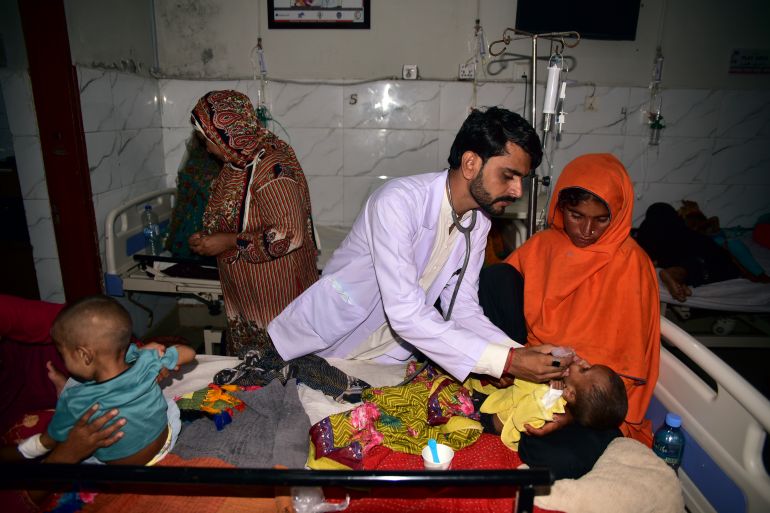Pakistan’s floods are still targeting millions of children
More and more malnourished, dehydrated children are coming to hospitals like mine. It’s a legacy of last year’s floods.

We never had a lot. But before last summer, most people living in my neighbourhood in Pakistan’s Sindh province got by, were safe and could afford to feed our children.
Last summer, everything changed when heavy rains and extreme floods – worse than anything I’ve ever seen in my life – brought misery to us all.
Keep reading
list of 4 itemsAt least 33 killed in Afghanistan as heavy rains set off flash floods
Drone video shows extent of snow-melt flooding Russia and Kazakhstan
Kremlin warns floods may worsen as Kazakhstan, Russia evacuate 100,000
I do not know anyone whose home wasn’t at least partially destroyed. Luckily, two rooms in my house were spared, but some extended family had their entire homes washed away, so we put them up and I slept in a car on the side of the road.
In the hospital where I had worked for less than a year, I felt like a soldier on the battlefield. We were the only functional health clinic left in the area, and as the water inundated villages, people inundated our corridors. With roads flooded, we were running out of the medicines we needed to fight for the lives of children and their families.
Imagine having to make life-or-death decisions in a matter of seconds. Then imagine having to do this while wading through three feet of floodwaters – nearly up to my hips – in the hospital and walking through flooded roads for six miles (9.6km) to work. Imagine having to do this when you are sleeping in your car. This was my life.
We were overloaded with patients; I have never seen anything like it. As well as medicines, there was a shortage of beds and mothers were crouching in the waterlogged corridors with babies in their arms. Just when I felt I was losing courage, I had to force myself to keep going – children’s lives depended on it.
Because the floods brought mosquitoes, malaria was everywhere. It is commonly accepted that a patient with a temperature of 106F (41C) is on death’s door – and with a thermal gun I recorded one person’s temperature at 109F (43C).
We were running out of antipyretic tablets to bring down fever. At one point, I started splitting them in half to try and help as many children as possible while we waited for more help to come. I also started making my own syrups for fever by crushing what medicines we had and boiling them in water. But at a certain point, there was nothing more to do than sponge the patients and hope for the best.
With children and families forced to sleep in the open air in freezing temperatures, we also saw a huge spike in pneumonia and seasonal flu. Adults might be able to battle against these temperatures, but younger children cannot because their immune systems are still fragile and weak. It can be difficult for them to survive.
Some children were turning up injured from chunks of their home having caved in on them, like the child who was brought unconscious after a wall collapsed on top of him. I thankfully managed to revive him, but only after spending longer performing CPR than I think I ever have on a single patient before. That felt like a miracle, as did the treatment of a boy with a urinary tract infection who had not passed urine for two days and was screaming in agony.
It was several months before we were able to get more medical supplies from Save the Children, thanks to a temporary route being constructed through the floodwaters. I was so relieved, but it didn’t take long for secondary health issues to set in.
Before the floods, about 20 percent of children visiting the outpatient department on any given day would be malnourished. That’s now up to 70 percent, so obviously, this is a very alarming situation.
One girl, just 10 months old, was desperately dehydrated, weak and lethargic when her mother brought her to me. She had severe acute malnutrition. We put her in our therapeutic feeding programme and admitted her for treatment – and eventually, she gained weight and began to recover.
Children in Sindh province today are lucky if they eat once a day. Crops have been destroyed, as well as the grain stores that were sources of income for so many families here. My area was effectively an island for months. People who were getting on fine are now completely reliant on charity to survive.
It’s been seven months and the water level is still so high that people can’t return to their homes. Luckily, I have been able to return to my home but that’s not the case for many people who are still living in tents. I have no idea if or when my family will be able to rebuild the part of our home that was destroyed.
The battle of last summer may be over, but the war is still ongoing. It shakes me to my core that this kind of destruction could become the new normal.
We are grateful for the support from Save the Children and other organisations. But my community needs more than just medicines to keep us alive – we need our homes rebuilt; we need to get back on our feet to earn a living to feed our children. We need a long-term plan from international leaders, and we need to be able to protect ourselves against future disasters.
We can’t relive this again.
The views expressed in this article are the author’s own and do not necessarily reflect Al Jazeera’s editorial stance.
